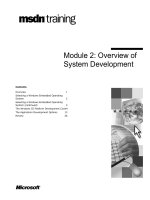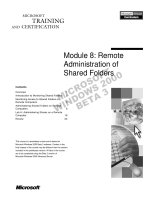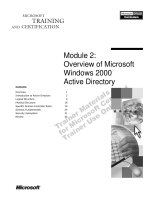Module III - Enumeration.Overview of System Hacking Cycle pot
Bạn đang xem bản rút gọn của tài liệu. Xem và tải ngay bản đầy đủ của tài liệu tại đây (4.12 MB, 18 trang )
Module III
Enumeration
Overview of System Hacking Cycle
Step 1: Enumerate users
Enumerate
• Extract user names using Win 2K enumeration and SNMP probing
Step 2: Crack the password
•
Crack the password of the user and gain access to the system
Crack
Crack the password of the user and gain access to the system
Step 3: Escalate privileges
• Escalate to the level of the administrator
Escalate
Step 4: Execute applications
• Plant keyloggers, spywares, and rootkits on the machine
Execute
Step 5: Hide files
• Use steganography to hide hacking tools and source code
Ste
p
6
:
C
over
y
our tracks
Hide
Tk
p6 C y
• Erase tracks so that you will not be caught
T
rac
k
s
What is Enumeration
Enumeration is defined as extraction of user names, machine names,
network resources shares and services
network resources
,
shares
,
and services
Enumeration techniques are conducted in an intranet environment
Enumeration involves active connections to systems and directed
q
ueries
The type of information enumerated by
intruders:
q
• Network resources and shares
•Users and groups
•
Applications and banners
Applications and banners
• Auditing settings
Techniques for Enumeration
Some of the techniques for
enumeration are:
• Extract user names using Win2k
enumeration
• Extract user names using SNMP
• Extract user names using email IDs
• Extract information usin
g
default
g
passwords
• Brute force Active Directory
Netbios Null Sessions
The null session is often refereed to as the Holy Grail of
Windows hacking Null sessions take advantage of flaws in
Windows hacking
.
Null sessions take advantage of flaws in
the CIFS/SMB (Common Internet File System/Server
Messaging Block)
You can establish a null session with a Windows
(NT/2000/XP) host by logging on with a null user name
and password
Using these null connections, you can gather the following
information from the host:
information from the host:
• List of users and groups
•
List of machines
List of machines
•List of shares
• Users and host SIDs (Security Identifiers)
So What's the Big Deal
Anyone with a NetBIOS connection to
your computer can easily get a full dump
of all your user names, groups, shares,
permissions, policies, services, and more
The attacker now has a channel over
which to attempt various techniques
permissions, policies, services, and more
using the null user
The followin
g
s
y
ntax connects to the
The CIFS/SMB and NetBIOS standards
in Windows 2000 include APIs that
return rich information about a machine
via TCP port 139—even to the
th ti t d
gy
hidden Inter Process Communication
'share' (IPC$) at IP address 192.34.34.2
with the built-in anonymous user (/u:'''')
with a ('''') null password
unau
th
en
ti
ca
t
e
d
users
This works on Windows 2000/XP
t bt t Wi
sys
t
ems,
b
u
t
no
t
on
Wi
n 2003
Windows: C:
\
>net use
\
\
192.34.34.2
\
IPC$
“”
/u:
””
Windows:
C:
\
>net
use
\
\
192.34.34.2
\
IPC$
/u:
Linux:
$ smbclient \\\\target\\ipc\$ "" –U ""
Tool: DumpSec
DumpSec reveals shares over a null session with the target computer
NetBIOS Enumeration Using
Netview
Netview
Th
Ni
l ll h
Th
e
N
etv
i
ew too
l
a
ll
ows you to gat
h
er
two essential bits of information:
• List of computers that belong to a domain
• List of shares on individual hosts on the network
The first thing a remote attacker will try on a
Windows 2000 network is to get a list of
hosts attached to the wire
•net view /domain
•Net view \\<some-computer>
•nbstat -A <some IP>
NetBIOS Enumeration Using
Netview (cont
’
d)
Netview (cont d)
Nbtstat Enumeration Tool
Nbtstat is a Windows command-line tool that can be used to display information about a
computer’s NetBIOS connections and name tables
•Run: nbtstat –A <some ip address>
C:\nbtstat
• Displays protocol statistics and current TCP/IP connections using NBT(NetBIOS over TCP/IP).
NBTSTAT [-a RemoteName] [-A IP address] [-c] [-n] [-r] [-R] [-s] [S]
[interval] ]
Tool: SuperScan
A powerful connect-based TCP port scanner, pinger, and hostname resolver
Performs ping scans and port scans by using any IP range or by specifying a text file
to extract addresses
Scans any port range from a built-in list or specified range
Resolves and reverse-lookup any IP address or range
Modifies the port list and port descriptions using the built-in editor
Connects to any discovered open port using user
-
specified
"
helper
"
applications
Connects to any discovered open port using user
-
specified helper applications
(e.g., Telnet, web browser, FTP), and assigns a custom helper application to any port
SuperScan: Screenshot
Screenshot for Windows
Enumeration
Enumeration
Enumerating User Accounts
•1.sid2user
id
Two powerful NT/2000
ti t l
•2.user2s
id
enumera
ti
on
t
oo
l
s are:
They can be downloaded at www.chem.msu.su/^rudnyi/NT/
These are command-line tools that look up NT SIDs from user name
in
put a
n
d v
i
ce ve
r
sa
put a d v ce ve sa
Enumerate Systems Using
Default Passwords
Default Passwords
Many devices like switches/hubs/routers might still be enabled with a “default password”
Try to gain access using default passwords
www.phenoelit.de/dpl/dpl.html contains interesting list of passwords
Tool: NBTScan
NBTscan is a
p
ro
g
ram for scannin
g
IP networks for NetBIOS name information
pg g
It sends NetBIOS status query to each address in supplied range and lists
received information in human readable form
received information in human readable form
For each responded host it lists:
IP address
NetBIOS computer name
NetBIOS computer name
Logged-in user name
MAC address
NBTScan: Screenshot
Tool: NetViewX
NetViewX is a tool to list the servers in a domain or workgroup
It is a bit like the NT "net view /domain" command
It allows to list only servers with specific services
It allows to list only servers with specific services
It uses a list format that is easily parsable









